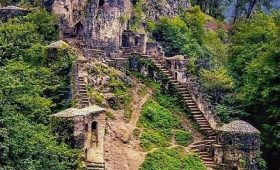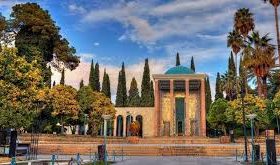Jahan Nama Garden, like other Iranian gardens, expresses the close relationship between the cultural and natural context and is a sign of adaptation and alignment of human and nature needs. The Persian garden has shown the hidden power of the environment and nature, and how to use it. Relying on his experimental knowledge, the creator of the garden has created an atmosphere which has caused the survival and dynamism of the natural bed.
Jahan Nama Garden was very green and prosperous during the rule of Al-Muzaffar and Al-Inju. This garden, like the three gardens of Eram, Delgosha and Takht-e Qaracheh, that are among the famous gardens of Shiraz, was finally settled and green before the invasion of Timur Gurkhani. Ibn Arabshah, the historian of the Timurid period, has called this garden Zinta al-Dunya in Wonderland.
Jahan Nama Garden was noticed by Timur Gurkhani during his stay in Shiraz, so that he built a similar garden around Samarkand, that was Timur’s birthplace, and called it “Jahannama”.
This garden was also very important during the Safavid period and is mentioned in the travelogue of Chardin, a French jeweler and tourist, but after the extinction of the Safavid dynasty, where insecurity pervaded the country, this garden was almost destroyed.
Explanation of this book: The city gate (Quran Gate) leads to a very beautiful street that is long and narrow. On both sides of this street there are gardens, the front of which is on the side of 200-foot street and each of them has a magnificent entrance with a half-dome arch and a pergola has been built on top of each entrance. The garden doors are facing each other on both sides and their symmetry has created an interesting situation. In the middle of this street, there is a square pond that is as wide as the street, and in order to be able to cross it on both sides, the entrance to the gardens on both sides is about thirty feet behind.
The narration of Mirza Mohammad, the sheriff of Persia, during the period of conflict between the claimants of the monarchy, after Nader Shah Afshar until the establishment of the government of Karim Khan Zand, this garden has also been reconstructed. The mansion located in the middle of the garden belongs to Karim Khan Zand.
Karim Khan Zand fenced this garden in 1185 AH and created beautiful alleys and elaborate tree planting around the mansion. After the Zandieh period, in the Qajar period, the Jahan Nama Garden was considered one of the most prosperous and magnificent gardens, and the garden mansion was a place for receiving government guests.
Lord Curzon, a British politician during the Qajar period, is one of the people who portrayed the Garden of the World in his book “Iran and the Case of Iran”. Describing the garden, he says: “On the other side of the road from Isfahan to Shiraz, a little higher than Hafeziyeh, is the Jahan Nama Garden, that was called Vakil Garden in the time of Karim Khan and changed its name during the reign of Fath Ali Shah when he was governor of Persia. They built there, including an enclosed area of about 200 yards, that now has several trees and is in decline. At the turn of the century, its central mansion, or pergola, was tidy and reserved for high-ranking British dignitaries, including VCG Rich, a British agent based in Baghdad who had made an exploration of Kurdistan and died of cholera on October 5, 1821. He died and was buried in the garden there.
The mansion of Bagh-e Jahan-e-Nama, which has survived from the time of Karim Khan, is intact in octagonal shape and is almost similar in appearance to the mansion of the pergola of Bagh-e Nazar. In the courtyard of the mansion and in the middle, a monolithic marble pool is built and four emperors are created in its four corners. The rooms between the emperors are two floors.
The facade of the Pergola Garden mansion is made of bricks. This mansion has no tiles or paintings. Of course, it is possible that there were already decorations that have disappeared over time and nothing is left.
In the past, this brick mansion had wooden windows that were removed by its private owner and replaced with iron windows.
Garden structure
The Persian garden has three unique features and designs: first, it is located in the waterway, second, it is surrounded by high walls, and third, inside the garden, there is a summer mansion with a water pool.
These three features, that are also present in Jahan Nama Garden, distinguish Iranian gardens from other gardens.
As can be seen in Jahan Nama Garden, in the architecture of Iranian gardens, four wide streets decorated with citrus and cypress trees lead to an octagonal mansion in the center of the garden. Inside the mansion there is a pool and a fountain from where water flows. The water streams that flow in these four streets usually have several fountains.




